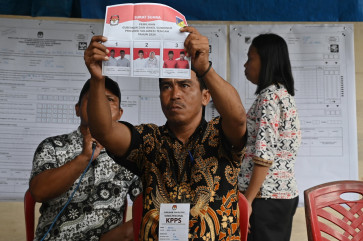Popular Reads
Top Results
Can't find what you're looking for?
View all search resultsPopular Reads
Top Results
Can't find what you're looking for?
View all search resultsSumatran tiger sperm bank
Deadly look: Ara, 17-year-old female Sumatran tiger, sits in her enclosure at Taman Safari Indonesia (TSI) conservation park in Cisarua, Bogor
Change text size
Gift Premium Articles
to Anyone
D
span class="caption" style="width: 558px;">Deadly look: Ara, 17-year-old female Sumatran tiger, sits in her enclosure at Taman Safari Indonesia (TSI) conservation park in Cisarua, Bogor. Ara’s lost part of a leg in a trap set up by oil palm growers in Riau in 1997.
In a crouching posture and with a sharp stare for any approaching figure, a tiger gave a loud roar audible some 10 meters away. It was Ara, a once deadly 17-year-old female Sumatran tiger (Panthera tigris sumatrae) now kept at Taman Safari Indonesia (TSI) conservation park in Cisarua, Bogor.
“Its right front leg was cut off after getting entangled in a trap set up by oil palm growers in Riau in 1997,” Irawan, head of the park’s education division, told The Jakarta Post at the TSI’s Sumatran Tiger Captive Breeding Center (PPHS) recently.
Sperm deposit: An employee checks tubes specially designed to keep the sperm of Sumatran tigers for years.Ara is one of the nine rare Sumatran tigers now being bred in captivity at PPHS. Discovered at the age of two, it is among those originally caught by local people in the forests of Sumatra. Some of them are old while others are physically impaired. These tigers are considered unfit for release into the wild.
The breeding ground covers 1 hectare of the TSI’s total area of 186 hectares on the slopes of Mount Pangrango. Closed to the general public, PPHS is the world’s only Sumatran tiger captive breeding center.
This center is tasked with rescuing the last of the three tiger sub-species once belonging to Indonesia, after Balinese tigers (Panthera tigris balica) and Javanese tigers (Panthera tigris sundaica) were declared extinct by the International Union for Conservation of Nature (IUCN) in 1940 and around 1980.
Well-planned: A board shows the schedule for collecting sperm from 11 Sumatran tigers in the park.Interestingly, the rescue is not only conducted through the natural process of reproduction, but also by building a Sumatran tiger sperm bank, so as to better guarantee the conservation of the last tiger sub-species in the country.
In 2007, at a workshop on the prevention of Sumatran tiger hunting and trading organized in Medan, North Sumatra, wildlife watchdog group Traffic Southeast Asia’s regional program officer Chris Shepherd said Sumatran tigers might go extinct by 2015.
Hunting, habitat fragmentation and forest burning have threatened the existence of Sumatran tigers, now listed as critically endangered animals, the highest category of threat. According to Shepherd, no less than 50 Sumatran tigers were traded in 2006, in whole form as well as in body parts.
Forum HarimauKita, a tiger rescue forum, referred to hunting and conflict with men as major threats to Sumatran tigers. Between 1978-1999, 146 cases of conflict were recorded. In 1998-2002, 38 tigers were killed, and in 2002-2004 the conflict claimed 40 human lives. Over 50 cases were noted in 2005-2007.
Guardian: A keeper watches the behavior of Harpan, a male Sumatran tiger, before he is placed in a “wedding enclosure” to be mated with Ara.
Sumatran Tiger Coordinator and president of the South East Asian Zoos Association (SEAZA), Jansen Manansang, said at least 18 world zoo institutions had shown their concern and given donations to ensure the continuity of the captive breeding of the endangered animals of Sumatra.
The government has also assigned the TSI to keep the studbook of the population of Sumatran tigers. The only Sumatran tiger studbook keeper in the world is Ligaya Ita Tumbelaka, a lecturer from the Veterinary Medicine faculty, Bogor Institute of Agriculture (IPB).
Meanwhile, the high value of protected animals has also made Sumatran tigers a medium of diplomatic communication to promote bilateral relations of Indonesia, as is the case with komodo dragons and orangutans. Sumatran tigers have been sent to Australia and Japan for the same purpose.
— Photos by JP/Wahyoe Boedhiwardhana













